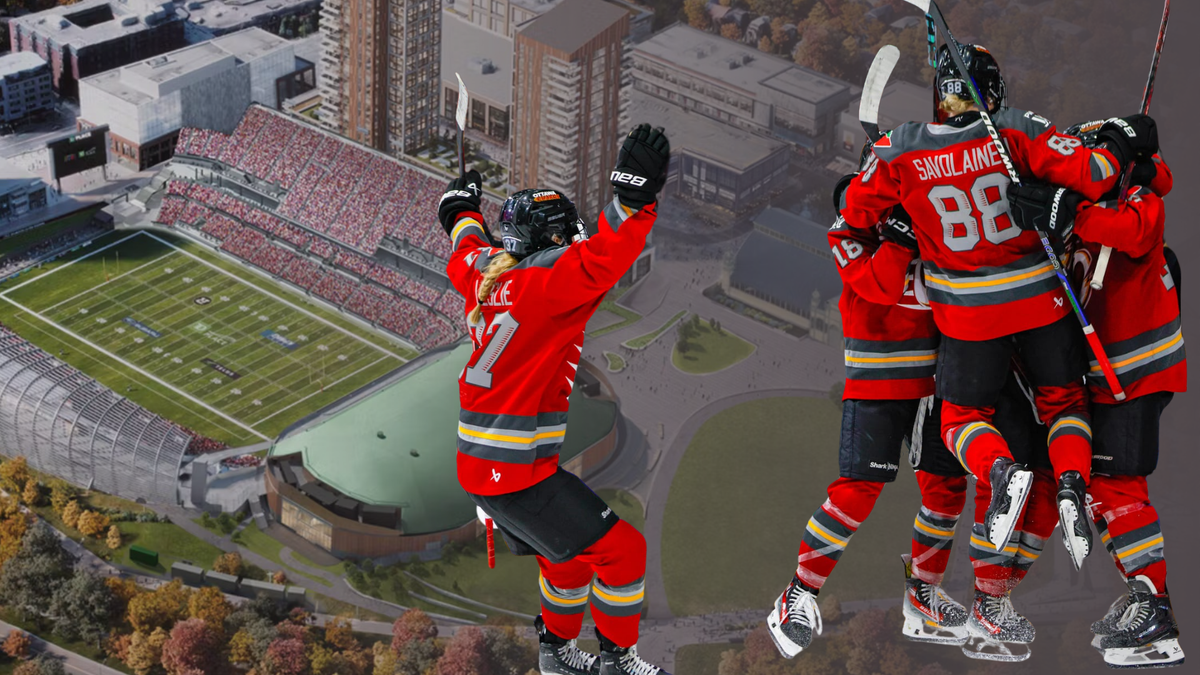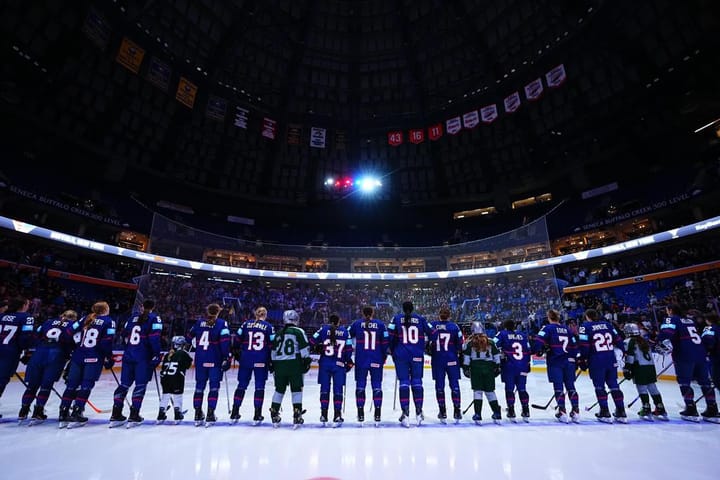Why Lansdowne 2.0 Needs to Happen
It’s not the arena we wanted, but it’s the one Ottawa needs right now.

I’ve lived in Ottawa my whole life. I love this city, its people, its sense of community. And I love women’s hockey. Covering the PWHL and watching Ottawa fans rally behind the Charge has been one of the most exciting things to happen here in years.
That’s why this isn’t easy to say, especially after something I wrote just a few months ago.
Back in August, I published a story titled “Ottawa’s New Arena Plans Are Failing Its Strongest Team.” In it, I argued that the new Lansdowne arena was too small, that it didn’t match the Charge’s success, and that the City was capping the growth of women’s hockey right when it was taking off.
I still believe the Charge deserve a bigger arena.
But after learning more about the actual condition of TD Place, how far the Lansdowne 2.0 process has already advanced, and what the financial and engineering realities look like, I’ve come to understand something that’s uncomfortable but true:
Lansdowne 2.0 needs to move forward, even if that means the Charge might not play there long term.
Since that August story, I’ve stepped back and dug deeper. I read City documents, watched council meetings, and tried to see the bigger picture. What I found led me to an honest conclusion: I wasn’t entirely wrong, but I was missing half the story.
Loving women’s hockey as deeply as I do, it was easy to see the arena plan only as an insult to the Charge. What I failed to grasp was that Lansdowne 2.0 isn’t about limiting the team, it’s about saving a rapidly deteriorating community asset.
The truth is, the arena at TD Place cannot continue much longer as it stands. Both the arena and the north-side stadium stands are nearly 60 years old and literally crumbling, “deteriorating and past their functional life span.” The facilities no longer meet modern standards for accessibility or energy efficiency, and the maintenance costs are increasing every year. Even costly patchwork repairs wouldn’t solve the core problem.

One of the most important facts is that the Lansdowne 2.0 plan was largely finalized before the PWHL even existed. When the City and the Ottawa Sports and Entertainment Group began designing the new arena concept in 2021 and 2022, there was no professional women’s hockey league to plan for, let alone an Ottawa franchise drawing thousands of fans.
If we don’t reinvest soon, we’ll start losing what we have, tenants, concerts, community events, and the economic activity that Lansdowne brings. Event organizers have already said they won’t return to the old arena. And every year of delay only drives construction costs higher.
“The cost of doing nothing is greater than the investment in Lansdowne 2.0.”
This isn’t a choice between a smaller arena and the perfect one we’d all prefer—it’s a choice between a smaller new arena or, eventually, no arena at all.
That reality hit me hard. Delaying or scrapping Lansdowne 2.0 in hopes of a bigger arena later could backfire badly. The arena’s problems won’t wait for a perfect plan. If the building were condemned, a plausible outcome given its age and “approaching obsolescence,” the Charge would be left without a home far sooner than a new venue could ever be built.
And that wouldn’t just hurt the Charge. The 67’s, the BlackJacks, concerts, and countless community events would all be displaced. I had to ask myself: what good is a bigger arena if there’s nowhere to play in the meantime?
Ultimately, a few key facts changed my perspective:
- The TD Place Arena is at its end of life. It’s 60 years old, structurally deteriorating, and no longer meets accessibility or safety standards. Maintenance is costly and unsustainable. The City owns it, which means that fixing or replacing it isn’t optional, it’s inevitable.
- Delaying only increases the cost. Each year of postponement risks losing tenants and events while construction costs rise. Officials have already said some events are boycotting Lansdowne until it’s upgraded. Waiting would make taxpayers pay more for the same result.
- The financing protects taxpayers. The $419 million project is structured so that nearly two-thirds of its cost will be covered by new revenues, through property taxes on new residential units, air-rights developments, and an enhanced OSEG partnership. The City’s share, about $146.6 million, is roughly one-third of the total. Normally, municipal projects are 100% taxpayer-funded. This one is not, and that’s rare.
- A modern, smaller arena still offers major upgrades. Though the seating bowl will shrink, the facility will finally be state-of-the-art, with better sightlines, more premium options, more concerts, improved accessibility and energy efficiency, and upgraded locker rooms. Crucially, the design includes tailored spaces for professional women’s teams like the Charge.
- And beyond the dollars: Keeping the Charge in a decaying arena might eventually push players away. If Ottawa wants to be a serious hockey city, not just for the fans but for the athletes themselves, it has to offer more than just a packed barn. It has to offer a place that’s safe, modern, and built for a high-performance environment. Letting the arena rot beneath a crumbling grandstand won’t keep elite players here.

Taken together, these facts paint a different picture than I saw in August. Lansdowne 2.0 isn’t a vanity project or against women’s hockey, it’s an urgent rescue effort to save a beloved public space while minimizing the burden on taxpayers. It’s a reinvestment that keeps Lansdowne viable for decades to come.
Let me be clear: the Charge do deserve a bigger arena. The outrage from fans and the PWHL came from love and belief in the team’s potential. I feel that too. It’s frustrating that after years of women’s sports fighting for recognition, we’re once again told to accept limitations.
But supporting women’s sports also means recognizing reality. In this case, backing Lansdowne 2.0 is the pro–women’s sports position, because the alternative could hurt the Charge even more. What good is an 8,500-seat arena if it’s unsafe or unaffordable to play in?
The Charge need stability, and Lansdowne 2.0 gives them that. Yes, it’s smaller—about 2,000 fewer seats, but it’s sustainable. The PWHL has warned that those lost seats could cost up to $1 million annually, even raising relocation concerns. Yet Mayor Mark Sutcliffe, a strong supporter of the plan, has acknowledged that the Charge’s long-term home may evolve as the league grows. He’s suggested a “way forward for the Charge in Ottawa,” potentially involving select games at larger venues like the Canadian Tire Centre or a future arena at LeBreton Flats.
As he put it, “we’re not building an arena just for one team.” That may sound frustrating, but it leaves the door open for flexibility and future growth.
And honestly, I’d rather see a packed 6,500-seat arena pulsing with energy than a half-empty 10,000-seat bowl. Scarcity builds demand, and momentum.
Some people will say I’ve sold out or stopped caring about the Charge. But my stance comes from the same place as before: love for the game and for this city.
Source List
- Kanata North – Lansdowne 2.0 FAQs and Mythbusters
https://www.kanatanorth.ca/lansdowne-2-0-faqs-and-myths-busters/ - City of Ottawa - Landsdowne 2.0 Fact Sheet
https://www.councillorallanhubley.ca/uploads/1/1/8/7/118753449/2025-0235_lansdowne-factsheet_en.pdf - PWHL's Ottawa Charge calls city's arena decision 'disappointing'
https://www.sportsnet.ca/pwhl/article/pwhls-ottawa-charge-calls-citys-arena-decision-disappointing/ - Lansdowne 2.0 Engage Ottawa
https://engage.ottawa.ca/lansdowne-2-0 - TSN Mornings Interview with Mark Sutcliffe
https://www.tsn.ca/radio/ottawa-1200/article/tsn-mornings-mayor-sutcliffe-says-if-lansdowne-20-passes-shovels-could-be-in-the-ground-before-2026/





Comments ()